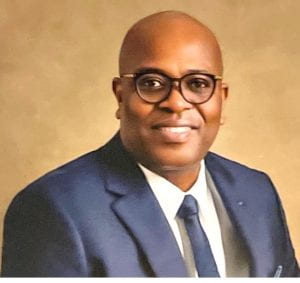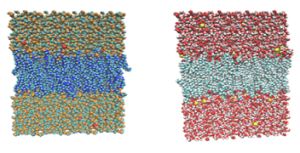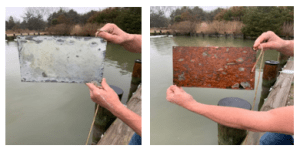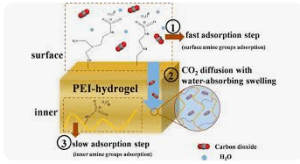
Kio, Michael P.E.
Assistant Research Professor
Chemical and Biomolecular Engineering
2208 Chemical and Nuclear Engineering Building
mkio@umd.edu
301-405-1923
Nanoparticle and Plasma Membrane Modelling
 The goal of this research interest is on Drug Carrier Transport Mechanism of Nanoparticles through the Plasma Membrane of Normal and Cancerous Cells. This research interest delivers a deeper and novel physical understanding of the transport mechanism and cytotoxicity of functionalized nanoparticles in cancer plasma membranes in comparison with healthy membranes; probing interactions, transport of nanoparticles as drug carriers, implementing Nanoscale Molecular Dynamics (NAMD) with models built with CHARMM-GUI membrane builder, CHARMM36 lipid and Martini force fields. Furthermore, I have been teaming up and working with Professor Jeffery Klauda and the research group on performing simulations on membrane-associated proteins analyzing their function and shape within bilayers, implementing deep learning and neural networks in dynamic modeling of biomolecules, improving polarizable force field, augmented sampling techniques to explore bonding with membranes and intracellular lipid transporter implementing molecular dynamics simulation.
The goal of this research interest is on Drug Carrier Transport Mechanism of Nanoparticles through the Plasma Membrane of Normal and Cancerous Cells. This research interest delivers a deeper and novel physical understanding of the transport mechanism and cytotoxicity of functionalized nanoparticles in cancer plasma membranes in comparison with healthy membranes; probing interactions, transport of nanoparticles as drug carriers, implementing Nanoscale Molecular Dynamics (NAMD) with models built with CHARMM-GUI membrane builder, CHARMM36 lipid and Martini force fields. Furthermore, I have been teaming up and working with Professor Jeffery Klauda and the research group on performing simulations on membrane-associated proteins analyzing their function and shape within bilayers, implementing deep learning and neural networks in dynamic modeling of biomolecules, improving polarizable force field, augmented sampling techniques to explore bonding with membranes and intracellular lipid transporter implementing molecular dynamics simulation.
A preliminary membrane model has been developed. This is the first-time a near-physiological normal and cancer plasma membrane model is developed implementing CHARMM36 and CHARMM-GUI Membrane Modeler. Various presentations have been given to both private and public audiences, with accompanying materials published accordingly.
Antifouling and Fouling Release Coating

The goal of this research interest proposes the research and development of an enhanced hybrid polymer antifouling, fouling-release, and anticorrosion coating formulation matrix for sea instruments, internal seawater systems, hulls, and keels of ships. This project synthesizes and characterizes a plurality of fumed silica and hydrogel-based polymer antifouling and anti-corrosion coating. Models are developed in the laboratory to probe these  phenomena by implementing computational and experimental techniques. Using NSF National I-Corp funds, a proof-of-concept prototype fouling-release coating formulation was created, with ongoing research continuing with the help of an NSF/ASEE fellowship. The expectation is the development of a pilot prototype and patent.
phenomena by implementing computational and experimental techniques. Using NSF National I-Corp funds, a proof-of-concept prototype fouling-release coating formulation was created, with ongoing research continuing with the help of an NSF/ASEE fellowship. The expectation is the development of a pilot prototype and patent.
Carbon Capture Implementing Biomaterials and Hydrogels

The concept of this research was born from the interplay between the study of modeling plasma membranes and developing anti-fouling coating formulations.
Microalgae have great potential in terms of CO2 fixation, yet their low diffusion ability and short CO2 residence time limit their effectiveness. Hydrogels can be used to immobilize microalgae as CO2 adsorbents, which increase their growth rate. Mutagenesis, genetic engineering, and nanomaterials are promising techniques to improve the biofixation of CO2 in microalgae, however, these methods still face many challenges. Therefore, further research into how relevant hydrogels and biomaterials can tolerate higher levels of CO2 concentration in order to effectively fix the CO2 is necessary.
Undergraduate Students
Abhi Senthikumar
Major: Chemical Engineering
Class of 2026
Alena Zheng
Major: Bioengineering
Class of 2025
Aryamann Singh
Major: Cell Biology and Molecular Genetics
Class of 2027
Srivishnu Pyda
Major: Computer Science
Class of 2025
